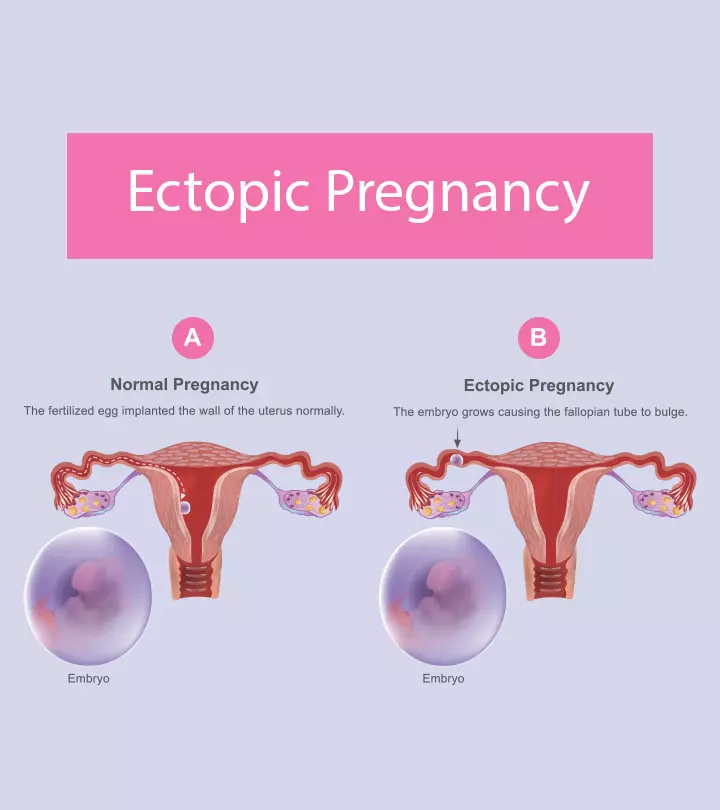
Image: Midjourney/ MomJunction Design Team
The postpartum belly does not return to its pre-pregnancy shape immediately after childbirth. Soon after delivery, it may look round and appear as if you are six months pregnant. Hormonal changes and involution of the uterus are the two major factors that help in decreasing the size of the postpartum belly. The process is slow, and the tummy tightening may require some time. Uterus involution and postpartum weight loss depend on the body’s calorie requirements and hormone changes during breastfeeding. Gentle exercises and a healthy diet may help hasten this process. Learn more about when the postpartum belly will reduce and some tips to speed up the process.

Key Pointers
- Postpartum belly looks saggy after childbirth due to overstretching of the abdominal muscles and a condition called rectus diastasis.
- The uterus reaches its pre-pregnancy stage six to two weeks after delivery, whereas the belly size reduces gradually.
- Some factors that may affect postpartum belly reduction are physical activities, breastfeeding, and the number of pregnancies.
- A healthy diet and gentle exercises may help tighten the abdominal muscles.
What Are The Causes Of Postpartum Belly?

Here are a few causes behind the appearance of the postpartum belly:
- Overstretching of abdominal muscles during pregnancy can cause a saggy appearance of the tummy after childbirth.
- Abdominal rectus diastasis or diastasis recti is a condition where the outermost abdominal muscles are separated due to forces stretching linea alba (connective tissue). This can be felt as a bulge in the tummy below the belly button (1).
- Extra fluid accumulations in the body can also make the postpartum belly look saggy and bulged. This should decrease steadily during the postpartum period (2). As a result, you may also experience weight loss in postpartum.
Breastfeeding is one of the best ways to reduce extra pounds gained in pregnancy, and it may also help with uterus involution. If you consult your doctor and there are no health issues, you may also try postpartum exercises.
 Things to know
Things to knowWhen Does The Postpartum Belly Go In?
The uterus usually contracts and reaches pre-pregnancy size within six to eight weeks after delivery (2). Your belly size can reduce further, and breastfeeding also aids in weight loss. Although some mothers may regain their pre-pregnancy body within a few weeks, it may not happen for most mothers. Linea nigra(dark line) in the tummy and other stretch marks usually fade within a few months after childbirth.
The following factors may play a role in the reduction of the postpartum belly.
- Physical activities and type of exercise

- Amount of weight gained during pregnancy
- Size and shape of tummy before pregnancy
- Breastfeeding
- Less weight gain during pregnancy
- Number of pregnancies
The more the abdomen is stretched during pregnancy, the more time it needs decreases. It may take more time for some mothers to lose weight after childbirth. You may pay more attention to breastfeeding and caring for the baby and yourself in the postpartum period than worrying about immediate weight loss. Even with proper nutrition and exercise, losing a postpartum belly may often take more than six months.
Postpartum Belly Timeline
Mothers can’t reach their pre-pregnancy flat tummy overnight after delivery. Although a few may regain the tummy shape pretty quickly, others may not. Postpartum belly size can change in the following time frames (3).
- After childbirth: Most women look six months pregnant after delivery. Nearly 15 pounds (6.8kg) can be reduced immediately after childbirth. This includes the weight of the baby, placenta, and amniotic fluid. However, the exact amount may vary depending on the baby’s birth weight and amount of amniotic fluid.
- Initial six weeks of postpartum: You may notice a gradual decrease in postpartum weight and belly size during this time since the excess fluid is removed from the body and uterus involutes to its previous size. Approximately one to two pounds (0.45- 0.9 kilogram) weight loss can be seen every month for six months.
- Beyond six weeks of postpartum: Abdominal muscles and skin can be more firm than initial weeks by this time. Although you may not reach pre-pregnancy weight by this time, you can feel changes when the uterus returns to its normal position and size. Most women may reach pre-pregnancy weight by nine months if they eat healthily, exercise, and breastfeed.

How To Make The Postpartum Belly Look Better?
The following home remedies for weight loss after delivery may help reduce the postpartum belly size and tighten the abdominal muscles.
1. Exclusive breastfeeding
Breastfeeding moms can lose weight easily during the postpartum period (4). The body requires more calories and nutrients to produce breast milk. Nearly 300 extra calories a day are spent in the initial weeks of breastfeeding. In addition to these, hormonal changes in breastfeeding can also boost uterus involution(10). Reduction in uterus size also helps to reduce the belly size and tighten belly skin after pregnancy. Gradual weight loss does not impact the breast milk supply.
2. Healthy diet

A well-balanced, low-calorie post-pregnancy diet can help many mothers to lose weight. However, fad diets may do more harm than good. Mothers need nutritious foods for breast milk production and to recover from childbirth. So staying away from essential nutrients during this time can cause deficiencies.
You may talk to your doctor or dietician about the calorie requirements based on your weight and activity levels. Including fresh fruits and vegetables, fiber-rich foods, whole grains, and avoiding high-sugar foods, high-fat foods, and junk foods with low nutritional value can help you maintain or lose weight in postpartum (11).
3. Gentle exercises
In the early weeks of postpartum recovery, gentle exercises to tone your tummy muscles. There are several exercises to reduce belly fat after delivery. Speak to your doctor about the recommendations for postpartum exercises since they can suggest you better based on individual factors such as type of delivery and health status.
Obstetrician and gynecologist, Dr Kelly Buchanan suggests, “You’ll want to take your time getting into an exercise and diet routine after giving birth. Your body needs time to heal.” She adds, “When you go back to more intensive exercise, remember, you’ll need to recondition yourself. You don’t want to start out where you left off. Start yourself up slowly. And be careful about the higher impact exercises for a little while (12).”You may begin with gentle exercises such as Kegels and walking and gradually increase the intensity to include core exercises. For example, trying pelvic floor exercises can help in toning and tightening your abdominal muscles and reducing belly fat. Pelvic floor exercises could be begun in early postpartum days, even if you had a C-section delivery. Similarly, walking can reduce clots, and core exercises such as crunches, planks, bridges, and bird-dog poses can help remedy diastasis recti, improving the ability to twist, pull, lift weights, and more. Physical therapy may also be beneficial in tightening the postpartum belly and remedying diastasis recti (12)(13). Studies indicate that an abdominal exercise program containing head lifts, abdominal curl-ups, and twisted abdominal curl-ups may strengthen and thicken the abdominal muscles without worsening diastasis recti, pelvic floor disorders, or other postpartum pains (14).
Carla West, a mother, personal trainer, and blogger, discusses her initial postpartum fitness routine. She reveals, “I started with belly breathing, aka TVA [transverse abdominis] breathing, since the first time I got up after birth. This was perfect for me because it’s a simple exercise that you can do anywhere, anytime! Even when holding a baby. Focusing on just my breath also helped me relax and de-stress. Spending a few minutes a day doing this helped me feel more like myself (i).”
 Quick tip
Quick tip4. Postpartum belly wraps, bands, and other shape wears

Various postpartum shapewear or compression garments can give the appearance of a reduced tummy. Some women find them comfortable and supportive, while others may not. Nevertheless, 82% of postpartum women expressed their intentions to use an abdominal binder after childbirth, as revealed by a cross-sectional observational survey conducted by multiple institutes (15). Although it supports abdominal muscles, the postpartum belly size usually reduces gradually as the uterus size decreases and the muscles become firmer over time.
Sharing her experience, Lydia describes her love-hate relationship with belly binding after her first c-section delivery because it dug into her incision when she sat. In her second pregnancy, however, she found the binding helpful following a VBAC (vaginal birth after cesarean) and writes, “After my second was born, I was kinda doing an experiment (an unscientific one) to see what the binding fuss was about… So instead, first I tried using an 6 inch wide ace bandage that I would wrap up in. I tried that for about two days. While standing that felt good. But once I sat down it rolled up and basically totally undid itself in about 30 mins. (No matter which way I tried to wrap myself.) Then it dawned on me that I have that old hospital issued binder, so I pulled it out. I actually found it to stay put much better this time than last. (I can’t tell you if that was based on the fact I was smaller, overall, this time than last. Or if it was just the difference between my c-section shaped belly and my VBAC shaped belly. Or if I was just less aware of how it sat on my body because I didn’t have an incision for it to dig into. Really, it could be all of the above.) And yep. Just like last time, I loved the feeling of it the first time I strapped it on. Instantly stronger and more upright. And this time I could wear it sitting down, which also felt great (ii).”
5. Emotional well-being
Caring for your mental health is just as important as physical recovery. Managing your stress and emotional health can help with weight loss and recovery, as high stress can make it harder to lose weight (5). Find supportive environments, seek support from friends and family, and participate in activities that relieve stress.
Most women may not regain exact pre-pregnancy shape even though they reach pre-pregnancy weight. Pregnancy can cause permanent body changes, such as a larger waistline, wider hips, and soft belly. So you may keep the fitness goal more realistic to stay healthy in the postpartum period.
Frequently Asked Questions
1. When should I start wearing a postpartum belly wrap?
If you have had a vaginal delivery, you may start wearing a postpartum belly wrap after two to four days of delivery. If you have had a C-section, you may wear the wrap after ten days to two weeks (6).
2. Does postpartum belly wrapping work?
Postpartum belly wrapping may support your hips, pelvic area, and back, improving your posture and making you stand taller. If you have had a C-section, a belly wrap may also support your incision as it heals (6) (7).
3. How long should I wear a postpartum belly wrap?
Most women wear a postpartum belly wrap for six weeks after delivery to support their healing and posture (6).
After delivering your baby, your postpartum belly may still look round and bulging. This is because the uterus and the belly that were overstretched during pregnancy take time to contract and regain their shape. However, some women may gain their original shape faster than others. So, the reduction of the belly depends on the shape of your tummy, weight gain, and breastfeeding pattern. If you want to lose your postpartum belly fast, breastfeed exclusively, eat a healthy diet, and follow a gentle exercise regime. Seek medical advice before taking any supplements or starting a fitness program.
Infographic: Tips To Help Reduce The Size Of The Postpartum Belly
During pregnancy, the abdominal muscles expand to accommodate the growing baby, and it takes time for your tummy to return to its pre-pregnancy state. It depends on various factors such as weight gain, pre-pregnancy structure, diet, and exercise. The infographic below suggests ways to help reduce the size of your postpartum belly.
Some thing wrong with infographic shortcode. please verify shortcode syntaxPersonal Experience: Source
MomJunction articles include first-hand experiences to provide you with better insights through real-life narratives. Here are the sources of personal accounts referenced in this article.
i. My first postpartum workout with Ayla was when I was still in hospital.https://medium.com/@carla_west_fitness/my-first-postpartum-workout-with-ayla-was-when-i-was-still-in-hospital-827979eaa40e ii. Postpartum Belly Binding.
https://walkingwithdancers.blogspot.com/2012/10/postpartum-belly-binding.html
References
- Treatment Options for Abdominal Rectus Diastasis.
https://www.ncbi.nlm.nih.gov/pmc/articles/PMC6877697/ - Chauhan G and Tadi P.; Physiology, Postpartum Changes.
https://www.ncbi.nlm.nih.gov/books/NBK555904/#:~:text=General%20Physiological%20Changes&text=The%20temperature%20is%20slightly%20elevated,and%20normalizes%20within%2012%20hours. - Breast-feeding and weight loss: What really happens?.
https://www.stclair.org/services/mayo-clinic-health-information/faqs/FAQ-20094993/ - Effects of breastfeeding on postpartum weight loss among U.S. women.
https://www.ncbi.nlm.nih.gov/pmc/articles/PMC4312189/ - Maternal Stress Predicts Postpartum Weight Retention.
https://www.ncbi.nlm.nih.gov/pmc/articles/PMC4251762 - The Benefits of Postpartum Belly Binding.
https://www.newlifebirthservices.org/new-life-blog/2025/4/14/the-benefits-of-postpartum-belly-binding - Postpartum Belly Wraps: Purpose Types Benefits & Risks.
https://health.clevelandclinic.org/postpartum-belly-wrap - Your post-pregnancy body.
https://www.nhs.uk/conditions/baby/support-and-services/your-post-pregnancy-body/ - What Really Helps You Bounce Back After Pregnancy.
https://www.hopkinsmedicine.org/health/wellness-and-prevention/what-really-helps-you-bounce-back-after-pregnancy - Uterus Involution.
https://my.clevelandclinic.org/health/diseases/22655-uterus-involution - Your Guide to Breastfeeding.
https://www.dignityhealth.org/content/dam/dignity-health/pdfs/central-california/merced-breastfeeding-guide-english.pdf - How To Lose Weight While Breastfeeding.
https://health.clevelandclinic.org/postpartum-weight-loss - Lingering abdominal bulge after baby? It could be diastasis recti.
https://utswmed.org/medblog/diastasis-recti-exercises/ - Sandra B Gluppe, Marie Ellström Engh, and Kari Bø; Curl-up exercises improve abdominal muscle strength without worsening inter-recti distance in women with diastasis recti abdominis postpartum: a randomised controlled trial.
https://pubmed.ncbi.nlm.nih.gov/37286390/ - Anita Madison, Leah Bryan, and Laura Faye Gephart; Prevalence of Planned Abdominal Binder Use after Vaginal Delivery.
https://pubmed.ncbi.nlm.nih.gov/34853848/
Community Experiences
Join the conversation and become a part of our nurturing community! Share your stories, experiences, and insights to connect with fellow parents.
Read full bio of Dr. Karla S. Sanchez-Banos
Read full bio of Dr Bisny T. Joseph
Read full bio of Rebecca Malachi
Read full bio of Reshmi Das

















